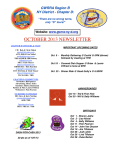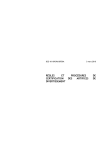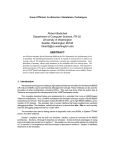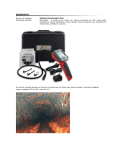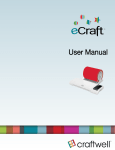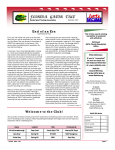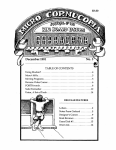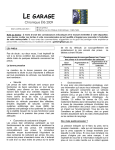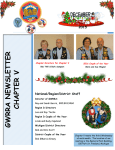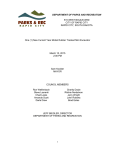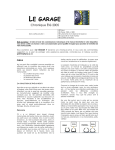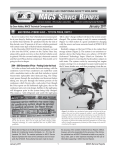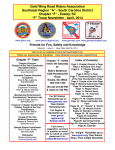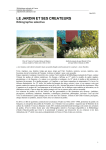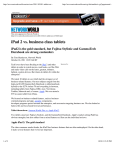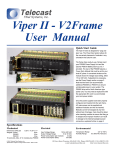Download November Newsletter - GWRRA NY Chapter T
Transcript
News Letter Checkout the Latest News from the N.Y. District: http://gwrra-ny.org/news.htm & GWRRA National’s News Letters GWRRA NY Chapter “T” November, 2015 Newsletter http://www.gwrra-ny-t.org/ http://gwrra.org/enewsletters.html 4 Cash Points As of 10/24/15 We have 17+ points DIRECTOR of GWRRA: Ray & Sandi Garris Rider Education Director: Tony Van Schaick Region B Directors: Tom & Renee Wasluck Region B Educator: Al & Vicki Stahl NEW YORK DISTRICT STAFF : District Director: Steve & Katy Nutting Asst. District Directors: Eastern—Gary & Donna Cork Western—Shawn & Dawn Hayes District Educators: John & Pam Van Deusen District Leadership Trainer: Shawn & Dawn Hayes District MAD Coordinators-TBA District Choy Coordinators: Pete & Marielle St. Chapter T meets at the Vienna Corners on the corner of Rt. 13 and Rt. 49 on the fourth Thursday of the month. Join us for a bite to eat @ 6PM with the meeting to follow at 7PM Chapter T Staff: Chapter T Director: Ted & Janice Zamorski \ [email protected] Asst. Director: Linda Clemens 315-762-4339 \[email protected] Treasurer: Jack & Joan Bisgrove 315-339-2452 \ [email protected] Ride Educator: Jim Thayer \ [email protected] Tech advisor: Lester Bennett \ [email protected] Newsletter editor: Jim & Trish Thayer \ [email protected] 2015 Chapter Couple: Jim & Trish Thayer MEC: Linda Clemens 315-762-4339 \[email protected] Recording Secretary: Sally Williams \ [email protected] Sunshine Coordinator: MaryAnn Bennett 315-339-4344 \ [email protected] Webmaster: Clark Clemens \ [email protected] Ride Coordinators: Jack Bisgrove & Bill Sweatman \ Photographer: Dan Brown \ Au9411@verizon,net Birthdays: Nov. 2 Sharon Learned Nov. 5 Kathy DeGroff Nov. 10 Bonnie Klossner Nov. 14-64 Ken Sweatman Nov. 22 Laina Sweatman Nov. 27 Linda Fletcher Anniversaries: Nov. 7 Frank & Shirley Beckler Nov. 19/1961 Al & Linda Yerdon Amour District Couple of the Year: Vacant District MEC: Pete & Marielle St. Amour District Public Relations: Linda Waterman District Treasurer: Eileen Guile Newsletter Editor: Phil & Tammy Coons District Webmaster: Clark & Linda Clemens NY District Facebook page: https://www.facebook.com/nygwrra Congratulations to All! Monthly Gathering 50/50 Winner 1 Janice Zamorski Chapter T’s Director’s Corner We Did it!!! O th n Friday, October 16 , Jim, Trish, Jack, Janice & I attended Chapter N’s meeting to secure the Traveling Plaque!!! This is the fifth time that Chapter “T” has captured this. Even though it may be short lived I am very proud that we were able to do this at this time. We sure had a crowd of 42 people adorn our meeting and want to thank everyone, which of course included our members, members of Chapter D and Chapter K, for being part of our night. We would also like to send a shout out to the Vienna Café for their great food and outstanding service. Let us not forget that November of course is a month of Thanksgiving. As the Chapter Director, I want to give a big thank you to the Chapter “T” dedicated Leadership Team for their time and effort to the membership. The Chapter T” staff listed on this Newsletter is the backbone to the success of our Chapter. They are always there to go the extra mile to add a fresh, creative twist to our get-togethers. I would also like to give thanks to the entire membership who supports our 50/50. Chapter “T” would like to thank all of our sponsors and we wish them the best throughout the upcoming Holidays and the remainder of the year. Our members and their friends are encouraged to frequent your establishments and spread the word. Happy Thanksgiving to all Chapter “T” members, their families, our sponsors, and fellow GWRRA members throughout the organization. On November 1st, it is time to fall back in time; that is go back to Eastern Standard Time. For most of us, it’s time to replace our two wheels for four wheels. Looking ahead, Bob Brown of Chapter N will be working with John Van Deusen to schedule a Trike Course or Advanced Riders course in April. John has also said he will be hosting a RCICP (Rider Course Instructor Certification Program) in Syracuse this Spring. More information to follow as we receive it. Some important dates : Nov. 19th –Chapter T meeting- Vienna Café January 8th-10th, 2016, Maryland District Cowboys and Cowgirls Winter Thing 2016. Clarion Resort Fontainebleau Hotel, 10100 Coastal Highway, Ocean City, Maryland . For more information, http://www.gwrra-md-district.org/index_files/WinterThing.htm January 16/2016- N.Y. District Meeting- Syracuse, NY- more information to follow. January 17, 2016 "WINGERS-N-WAVES Cruise" sponsored by the GWRRA Georgia District. The cruise consists of 7 days and 6 nights of WOW. The cruise is open to all Chapters, family and friends. The event is not affiliated with the GWRRA National. For information visit www.wingersnwaves.com or call (386) 299-7535. June 7th-11th,2016-Americade-Lake George July 21-23, 2016 GWRRA New England Districts Rally in the Valley, Fireside Inn, 25 Airport Rd., West Lebanon, NH 03784. Registration is $55 for members and $50 for Life members. More information to come. Aug 4-6, 2016 GWRRA NY/NJ BI-STATE CONVENTION, Holiday Inn, 1 Pureland Dr.,Swedesboro, NJ 08085. Room Rates $99.00 and includes breakfast. The theme will be Mardi Gras. Rally registration is $54.00. The hotel is right off I-295 in NJ across the river from Wilmington, DE. Sept 1-4, 2016 GWRRA Wing Ding 38, MetraPark, Billings, Montana. For information call Member Services at 800-843-9460 or visit wing-ding.org. Happy Thanksgiving ***Ride Safe & Offer More Visibility*** Ted and Janice 2 J NY Ch im Thayer apter T Educat or NY “T “Rider Education Page: IT'S ALL ABOUT TRACTION BY CHUCK AND LESLIE DONALDSON, AZ-R TRIKE COORDINATORS Traction is the amount of grip that your tires have on the road surface. Three factors affect traction: side force when in a turn or curve, driving force of the engine. and braking. All of these factors are Interrelated. Using too much of any one individually or in any combination can result in a loss of traction, and along with it, loss of control of your trike. Before we discus the how-to and when-to of braking your trike in different scenarios, here are some general rules to follow: • Look straight ahead with your eyes up. • Square the handlebars, • Brake firmly and progressively to avoid wheel lockup. • With only minor exceptions, both brakes should be used simultaneously. (Gently applying the rear brake only, may be appropriate to control speed when making slow speed maneuvers and when on downgrades and for unstable road surfaces such as gravel, sand, snow. etc.) • If you experience a front-wheel skid while in a turn or curve, your trike will attempt to travel in a straight line, If this occurs, straighten the handlebars and ease up on the brake to regain traction. If you keep your handlebars turned and regain traction, the sudden Increase in centrifugal force toward the outside of the turn or curve could cause a rollover. • If you experience a rear wheel skid, steer into the skid as you would In a car., and ease off of the rear brakes until you regain traction. Hydroplaning Hydroplaning results when your tires lose contact with the road. This often occurs in rainy conditions and can be exacerbated by oily residue left on many road surfaces. When you sense that your trike is hydroplaning, gently let off on the throttle and allow the vehicle to slow down until the tires reestablish their grip on the road surface, and THEN apply your brakes. Attempting to adjust your path of travel by steering or applying your brakes while hydroplaning could send you into a spin. Swerving A hard swerve should be the maneuver of last resort. A sharp or sudden swerve may move your vehicle into oncoming traffic, into a lane with high-speed traffic traveling in the same direction or onto an unstable shoulder. That said, if you are unable to avoid an object by braking, swerving might be your only option. While in a hard swerve, do not apply your brakes. Centrifugal force will shift the center of mass of your trike laterally toward the arc of the curve and could cause your trike to spin, or worse, to flip. By applying your brakes only after returning to a straight line of travel. and with your handlebars straightened, you will reduce this lateral momentum. Breaking in turns and corners As stated in the general rules above, square up your trike and handlebars before applying your brakes. It is vitally important when hard braking is required that the trike be squared up and straightened. This will provide the quickest stop. A second method is to gradually apply both brakes as the trike 3 squares. Again make sure the handlebars are straightened before applying final, maximum brake pressure. As with braking while swerving, braking in a turn or curve causes increased centrifugal force. This in turn, can shift more of the center of mass of your trike toward the arc of the curve. If you brake hard enough to cause front wheel lockup (a skid) and then regain traction. the trike will immediately try to change direction, which could result in a crash. Braking is another learned skill - so practice, practice, practice. Attend Parking Lot Practices. Practice Field Days and Trike Rider Courses In your area. They are a great opportunity to become safer riders. 4 Winter Storage TECH CORNER with Lester Bennett & Dave Secor Total Motorcycle's 10 Step Guide to Winterizing your motorcycle. Outside a single white snowflake falls... Disbelief falls on your face as another snowflake falls... Then you realize, another riding year over and it's time to put the bike away for the winter. This is the time to get in that last few riding days and put our bikes properly away for the winter so they are ready for the next riding season to start again. Storing your bike for winter: Well, it's that time of year again! Soon the snow will be falling and the motorcycles will be tucked away for the winter. And each spring your dealer's phone will ring off the wall with customers who did not store the of bike properly and now wonder why it won't run. Some preparation now will ensure that you are out riding in the spring instead of waiting in the dealer's lineup. 1: Location - where are you going to put it? One solution may be to ask your dealer if he offers a storage program. This is ideal because he will often prep, store, and have the bike ready to ride when you are ready again. If you decide to store it yourself, you will need a place that is dry and out of harm's way. When possible. Chose a location away from windows. The ultraviolet light can fade paint and plastic parts. Direct sunlight can raise the ambient temperature of the storage area which will promote condensation when the sun goes down, so cover plain glass with some sort of opaque material. Also, cover your bike with a specially designed bike cover not a sheet or a tarp. Why? Because a sheet absorbs moisture and hold it against metal surfaces and then rust forms. Also, damp fabric will breed mildew and this may attack the seat material. A tarp prevents moisture from getting in but it also prevents it from getting out. Moisture trapped will condense on the bike and then the rust monster is back! A specially designed motorcycle cover is made of a mildew resistant material. The material is slightly porous, so it can breathe. 2: Change The Oil Tip: Just like cars a colder winter grade oil will allow your bike to start easier in colder weather. If your motorcycle runs ok with a cold winter grade oil (5w30) then changing the oil to this grade will help startup and running in spring. Even if the oil is not due for a change, byproducts of combustion produce acids in the oil which will harm the inner metal surfaces. Warm the engine to its normal operating temperature, as warm oil drains much faster and more completely. While you are at it, why not change the filter too? Add fresh motorcycle grade oil. Remember to dispose of the drained oil and old filter in a responsible manner. What to do with the old oil? Recycle it. Most stores you have purchased the oil from will take it back free of change to be recycled. 3: Add Fuel Stabilizer And Drain Carbs Tip: You only need to drain the carbs if your motorcycle will be stored more than 4 months. Otherwise just add fuel stabilizer to the gas tank, run the bike for 10 minutes so it mixes and gets into the carbs. Fill the tank with fresh fuel, but do not overfill. The correct level is when the fuel just touches the bottom of the filler neck. This gives enough room for the fuel to expand without overflowing the tank when temperature rises. Shut off the fuel petcock and drain the carburetors and the fuel lines. Add winterizing fuel conditioner to prevent the fuel from going stale, and help prevent moisture accumulation. Stale fuel occurs when aromatics (the lighter additives) evaporate leaving a thicker, sour smelling liquid. If left long enough, it will turn into a gum, plugging the jets and passages inside your carbs! 4: Lube the cylinder(s) Tip: You only need to do this if your motorcycle will be stored a very long time (6 months or more) Because gasoline is an excellent solvent and the oil scraper ring has done its job, most of the oil from the cylinder walls have been removed since the last time the engine was run. If the cylinder wall is left unprotected for a long period of time, it will rust and cause premature piston and ring wear. Remove the spark plugs and pour a tablespoon (5 cc) of clean engine oil or spray fogging oil into each cylinder. Be sure to switch off the fuel before you crank the engine or else you may refill the drained carbs! Also, ground the ignition leads to 5 prevent sparks igniting any fuel residue. Turn the engine over several revolutions to spread the oil around and then reinstall the plugs. Refitting the plugs before cranking the engine could result in a hydraulic lock if too much oil was used in the cylinder. 5: Battery Storage The battery must be removed from the motorcycle when it is in storage. Motorcycles often have a small current drain even when the ignition is switched off (dark current), and a discharged battery will sulfate and no longer be able to sustain a charge. A conventional battery should be checked for electrolyte level. Add distilled water to any of the cells that are low and then charge the battery. Battery charging should be performed at least every two weeks using a charger that has an output of 10% of the battery ampere hour rating. For example if the battery has an AH rating of 12 (e.g. 12N12A-4A-1 where the 12A is 12 amp hours), then the charge rate of that battery should not exceed 1.2 amps. A higher charge will cause the battery to overheat. Charge the battery away from open flame or sparks as the gas (hydrogen) given off a battery can be explosive. Elevate the battery and keep it from freezing. Exercise the proper caution appropriate to caustic substances. 6: Surface Preparation Waxing and polishing the motorcycle might seem like a waste of time since you are putting it away and no one will see it. But applying wax is a very important part of storing a motorcycle.Wax will act as a barrier against rust and moisture. Don't forget to spray any other metal surfaces (such as the frame or engine) will a very light spray of WD-40. This will keep these areas shiny and protect from corrosion as well. 7: Exhaust and Mufflers Exhausts/Mufflers are known to rust fast when they are not used. So making sure they are properly stored for the winter on your bike will save them from an early rusty death. Spray a light oil (such as WD40) into the muffler ends and drain holes. Lightly stick a plastic bag (shopping bag is fine) into the end of each muffler hole (to keep moisture from getting inside the exhaust). Then cover each muffler with another plastic bag to keep outside moisture off. 8: Tires Check both front and rear tires with your air pressure gauge. Make sure each tire is properly inflated to the maximum recommend pressure. As it gets colder, air condenses in your tire so it is important to pump them up as to keep your tires healthy. Rubber is a flexible material and does not like to freeze (it cracks when it freezes). Placing 1/4"-1/2" piece of cardboard or wood board under each tire will help keep the rubber raised up from a freezing floor. DO NOT use a tire dressing on tires (such as Armor-All or tire cleaning foam) as this will make the tires hard and slippery. 9: Service all fluids If the brake or clutch fluids haven't been changed in the last two years or 18,000 km (11,000 miles), do it now. The fluids used In these system are "hygroscopic" which means that they absorb moisture. The contaminated fluid will cause corrosion inside the systems which may give problems when the motorcycle is used next spring. Be sure to use the correct fluids and note the warnings and instructions in the service manual. If you don't have the experience to service these systems, contact your dealer, he will be happy to assist you. If your motorcycle is liquid cooled, the coolant requires changing every two years or 24,000 kms (15,000 miles). Make sure that the engine is cool enough to rest your hand on it before draining the system and please dispose of the coolant responsibly. Coolant/antifreeze is available from your dealer and has been developed to provide the correct protection for your motorcycle engine. Mixed 50/50 with distilled water will ensure a clean system for the next two years or 24,000 kms (15,000 miles). 10. Cover it. Now you can cover the bike with the cycle cover and look forward to the first warm day of spring. Back On The Road Before you head out onto the highway, there are a couple of things to do. First, remove the cover and put it where you can find it again. Talking of finding things, locate the (charged) battery and reinstall it connecting the positive (+) cable (red) before the (-) negative and covering the terminals with the plastic covers. Recheck all fluid levels and turn on the fuel. Check for anything wrong on the motorcycle (cracked tires, broken parts/ plastic, leaking oil). Set the tire pressures back to riding specs and you are ready to fire up. As you don your riding gear, remember that your riding skills will be a little rusty and the road surfaces will have changed a bit since the last ride, so go carefully. Sand/salt deposits on the edge of the road and especially at corners may be hazardous. 6 Sun Mon Tue Wed Thu Dinner Ride Gone Coastal Lee Center, NY 6:00pm Fri Sat 1 2 3 4 5 6 7 8 9 10 11 12 13 14 15 16 17 18 19 Chapter T 20 Gathering at the Vienna Corners Dinner—6:00 pm Meeting 7:00 pm 21 22 23 24 25 26 28 29 30 27 November 2015 Sun Mon Tue 1 Wed Thu Fri Sat 2 3 4 5 9 10 11 12 Chapter”T”s December 2015 6 7 8 Christmas Party 6:00pm at Franklin Hotel Rome,NY NY Utica, 13 14 15 16 17 18 20 21 22 23 24 25 27 28 29 30 31 7 19 Merry Christmas To ALL 26 Maryland District invites you to come dressed in your best Hoedown attire. The costume contest Friday evening will be judged during the dance on creativity, uniqueness, and a sense of elegance. Winner takes home $50 prize and gets their picture posted on the district website for the entire year! Thursday Evening Friday & Saturday Friday Afternoon Friday Evening Saturday Afternoon Saturday Evening - Ice Cream Social & 50/50 - Hospitality Room & Seminars - MD District COY Selection - Hoedown Throwdown Dance & 50/50 - Chapter Wii Bowling, Matchbox Race Games, and Rider-Ed Raffle - Banquet, Grand Prize raffle & 50/50 Clarion Resort Fontainebleau Hotel 10100 Coastal Highway Ocean City, Maryland 21842 The Clarion Resort Fontainebleau Hotel is Ocean City’s finest full-service hotel, located on the beach. Amenities include room service, bellman, live entertainment on Friday and Saturday night, an oceanfront restaurant & nightclub, indoor pool, spa, fitness facility, and a Saturday/Sunday brunch. In-room amenities include: high-speed Internet access, luxury ocean view, microwave, refrigerator, and safe. Luxury 1, 2 & 3 bedroom oceanfront condos are available through the reservations desk and located immediately adjacent to the hotel. Call before December 16, 2015 to reserve your room! 1-800-638-2100 Mention GWRRA MD District WinterThing Event & receive the special WinterThing rates (below). Arrive early; stay late! Event rates are applicable 2 days before and 2 days after the event, based upon availability of rooms! Double/Double Executive King Studio King $ 79.00 $ 99.00 $ 109.00 One BR Condo Two BR Condo Three BR Condo $ 99.00 $ 139.00 $ 199.00 Room rates are per night, based on single or double occupancy. Condo rates are per night, based on 2 persons per bedroom; extra persons are $15.00 per night. Note: Condo services are limited to trash removal and fresh towels








